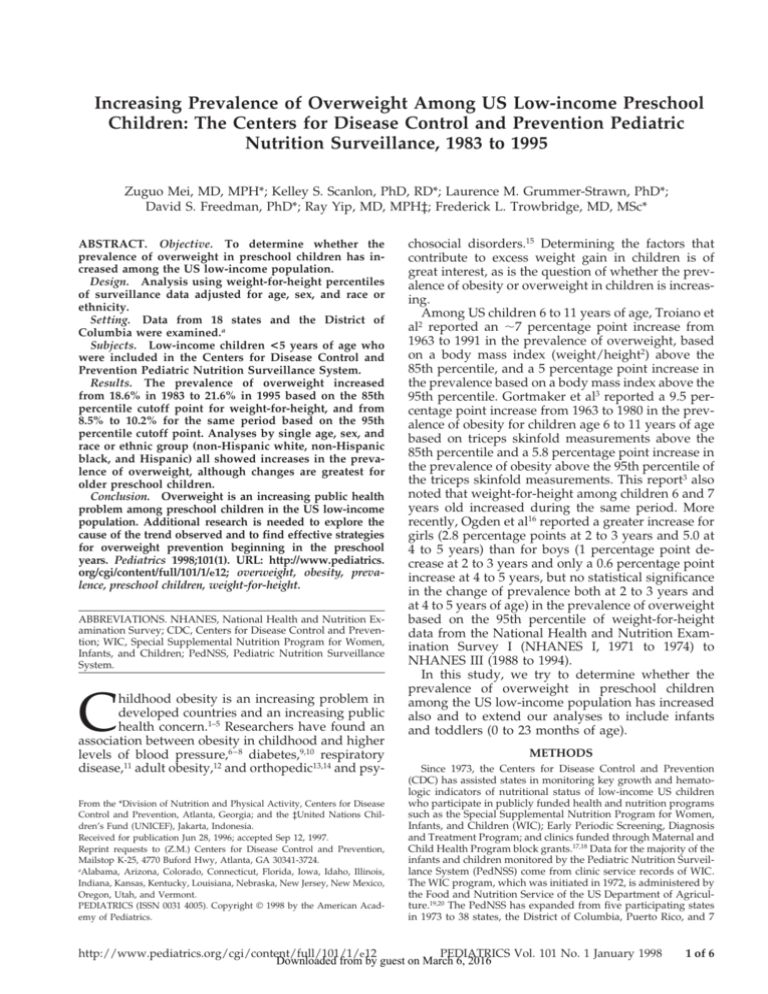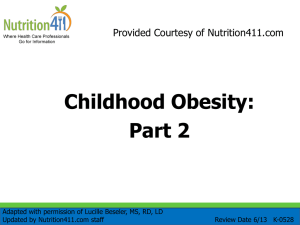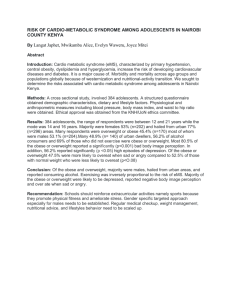
Increasing Prevalence of Overweight Among US Low-income Preschool
Children: The Centers for Disease Control and Prevention Pediatric
Nutrition Surveillance, 1983 to 1995
Zuguo Mei, MD, MPH*; Kelley S. Scanlon, PhD, RD*; Laurence M. Grummer-Strawn, PhD*;
David S. Freedman, PhD*; Ray Yip, MD, MPH‡; Frederick L. Trowbridge, MD, MSc*
ABSTRACT. Objective. To determine whether the
prevalence of overweight in preschool children has increased among the US low-income population.
Design. Analysis using weight-for-height percentiles
of surveillance data adjusted for age, sex, and race or
ethnicity.
Setting. Data from 18 states and the District of
Columbia were examined.a
Subjects. Low-income children <5 years of age who
were included in the Centers for Disease Control and
Prevention Pediatric Nutrition Surveillance System.
Results. The prevalence of overweight increased
from 18.6% in 1983 to 21.6% in 1995 based on the 85th
percentile cutoff point for weight-for-height, and from
8.5% to 10.2% for the same period based on the 95th
percentile cutoff point. Analyses by single age, sex, and
race or ethnic group (non-Hispanic white, non-Hispanic
black, and Hispanic) all showed increases in the prevalence of overweight, although changes are greatest for
older preschool children.
Conclusion. Overweight is an increasing public health
problem among preschool children in the US low-income
population. Additional research is needed to explore the
cause of the trend observed and to find effective strategies
for overweight prevention beginning in the preschool
years. Pediatrics 1998;101(1). URL: http://www.pediatrics.
org/cgi/content/full/101/1/e12; overweight, obesity, prevalence, preschool children, weight-for-height.
ABBREVIATIONS. NHANES, National Health and Nutrition Examination Survey; CDC, Centers for Disease Control and Prevention; WIC, Special Supplemental Nutrition Program for Women,
Infants, and Children; PedNSS, Pediatric Nutrition Surveillance
System.
C
hildhood obesity is an increasing problem in
developed countries and an increasing public
health concern.1–5 Researchers have found an
association between obesity in childhood and higher
levels of blood pressure,6 – 8 diabetes,9,10 respiratory
disease,11 adult obesity,12 and orthopedic13,14 and psyFrom the *Division of Nutrition and Physical Activity, Centers for Disease
Control and Prevention, Atlanta, Georgia; and the ‡United Nations Children’s Fund (UNICEF), Jakarta, Indonesia.
Received for publication Jun 28, 1996; accepted Sep 12, 1997.
Reprint requests to (Z.M.) Centers for Disease Control and Prevention,
Mailstop K-25, 4770 Buford Hwy, Atlanta, GA 30341-3724.
a
Alabama, Arizona, Colorado, Connecticut, Florida, Iowa, Idaho, Illinois,
Indiana, Kansas, Kentucky, Louisiana, Nebraska, New Jersey, New Mexico,
Oregon, Utah, and Vermont.
PEDIATRICS (ISSN 0031 4005). Copyright © 1998 by the American Academy of Pediatrics.
chosocial disorders.15 Determining the factors that
contribute to excess weight gain in children is of
great interest, as is the question of whether the prevalence of obesity or overweight in children is increasing.
Among US children 6 to 11 years of age, Troiano et
al2 reported an ;7 percentage point increase from
1963 to 1991 in the prevalence of overweight, based
on a body mass index (weight/height2) above the
85th percentile, and a 5 percentage point increase in
the prevalence based on a body mass index above the
95th percentile. Gortmaker et al3 reported a 9.5 percentage point increase from 1963 to 1980 in the prevalence of obesity for children age 6 to 11 years of age
based on triceps skinfold measurements above the
85th percentile and a 5.8 percentage point increase in
the prevalence of obesity above the 95th percentile of
the triceps skinfold measurements. This report3 also
noted that weight-for-height among children 6 and 7
years old increased during the same period. More
recently, Ogden et al16 reported a greater increase for
girls (2.8 percentage points at 2 to 3 years and 5.0 at
4 to 5 years) than for boys (1 percentage point decrease at 2 to 3 years and only a 0.6 percentage point
increase at 4 to 5 years, but no statistical significance
in the change of prevalence both at 2 to 3 years and
at 4 to 5 years of age) in the prevalence of overweight
based on the 95th percentile of weight-for-height
data from the National Health and Nutrition Examination Survey I (NHANES I, 1971 to 1974) to
NHANES III (1988 to 1994).
In this study, we try to determine whether the
prevalence of overweight in preschool children
among the US low-income population has increased
also and to extend our analyses to include infants
and toddlers (0 to 23 months of age).
METHODS
Since 1973, the Centers for Disease Control and Prevention
(CDC) has assisted states in monitoring key growth and hematologic indicators of nutritional status of low-income US children
who participate in publicly funded health and nutrition programs
such as the Special Supplemental Nutrition Program for Women,
Infants, and Children (WIC); Early Periodic Screening, Diagnosis
and Treatment Program; and clinics funded through Maternal and
Child Health Program block grants.17,18 Data for the majority of the
infants and children monitored by the Pediatric Nutrition Surveillance System (PedNSS) come from clinic service records of WIC.
The WIC program, which was initiated in 1972, is administered by
the Food and Nutrition Service of the US Department of Agriculture.19,20 The PedNSS has expanded from five participating states
in 1973 to 38 states, the District of Columbia, Puerto Rico, and 7
http://www.pediatrics.org/cgi/content/full/101/1/e12
PEDIATRICS Vol. 101 No. 1 January 1998
Downloaded from by guest on March 6, 2016
1 of 6
Indian Reservations in 1995. This surveillance system provides a
rich source of data for studying the nutritional characteristics of
low-income children on a state-by-state basis.17,18
In the PedNSS system, height or length is measured to the
nearest 0.1 cm or 1/8 inch. According to the protocols, a measuring board is used to measure the child’s recumbent length if the
child is ,24 months of age; otherwise, a standing height is measured for children .24 months. Weight was measured to the
nearest 0.1 kg or 1⁄4 pound using a pediatric scale or other beam
balance scale.21,22 All the records are entered onto a standardized
paper form or onto an automated computer system in the clinics.
Once the records are computerized at the state level, they are
transferred to the CDC for inclusion in the PedNSS database.
To study the trend in prevalence of overweight from 1983
through 1995, we selected all children 0 to 59 months old from the
18 statesa (plus the District of Columbia) who participated consistently in the PedNSS during this period. Among the 18 states and
the District of Columbia, we checked the data quality by using the
anthropometric data quality assurance indexes22,23 across states
and years within each state to verify whether the data are comparable. Because a nearly constant variance in height- and weightbased z score distributions is indicative of data quality,23 the SD
units of weight-for-height z score were used to check the data
quality across states and years. We found the that the SD units of
the z score distribution were within the normal range (0.85 to
1.10)23 and were stable. Also, we tracked the height-for-age z score
across years for each state included in this analysis to examine
whether an increasing bias of measuring children too short could
affect the overall overweight trend. We found that there was no
change in the mean height-for-age z score across years for all the
states in the dataset. Furthermore, the records of the children with
missing ages were automatically excluded before they were transferred to the PedNSS database. The percents of missing height/
length and weight were 1.5% and 1.1%, respectively. The percent
of records with biologically implausible values of weight-forheight (z score below 24 or above 15)23 was 0.5%.
To examine whether the criteria for enrollment in these publicly
funded health and nutrition programs remained approximately
the same from 1983 to 1995 in the selected 18 states and the District
of Columbia, a survey was conducted in those states regarding
any certification criterion or priority changes for overweight in the
programs during the 13 years.
Because the PedNSS, which receives data from publicly funded
health and nutrition programs, has multiple records on children
per calendar year and a disproportionate number of first visit
records for young infants, one record per child per visit year was
randomly selected to avoid double counting of children who visit
TABLE 1.
Data
the program more than once in a calendar year. Repeat visits were
identified using the unique WIC identification number, which is
maintained for WIC administration. The final sample for this
study was 15 029 147 preschooler clinic records.
To examine trends more generally for children ,5 years old, we
age-adjusted the prevalence estimates for each year, assuming a
uniform age distribution. To do this, we weighted the data so that
the prevalence of each single month of age was weighted equally.
The results were also adjusted for race or ethnicity and for sex,
assuming that the ethnic mix for all 13 years combined applies for
each calendar year, and assuming that there should be 50% boys
and 50% girls.
We examined trends by the urban/rural classification of the
county in which the clinical measurements were taken using the
Census Bureau definition of urban and rural. To examine how the
CDC PedNSS low-income preschooler population differs from the
US general population at the same ages, we compared the demographic and anthropometric characteristics of the PedNSS data
with NHANES II and III data.
In recent years, several studies have shown that the current
NCHS/CDC growth reference sections based on the Fels sample
(,2 years of age) and the part based on the national representative
NHANES I sample ($2 years of age) are not comparable. When
the two curves are compared, there is a clear disjunction of heightfor-age and weight-for-height at 24 months of age.24,25 These disjunctions make it difficult to compare the growth status of children ,2 years of age with that of children .2 years of age. Because
of the disjunction, we also performed the trend analysis separately
for these two age groups.
There is no generally accepted definition of obesity or overweight for children and adolescents.26,27 Various criteria for overweight and obesity have been used to estimate prevalence and
trends among children and adolescents.3,28,29 For this study, we
used weight-for-height status above the 85th and 95th percentiles
of the NCHS/CDC weight-for-height reference to estimate the
prevalence of overweight or obesity in our study population. We
calculated weight-for-height percentiles and z scores by using the
NCHS/CDC age- and sex-specific growth reference.30,31 Any
weight-for-height z scores below 24 or above 15 were excluded,
because these extreme values were most likely attributable to
errors in measurement or data entry.23
RESULTS
From the survey among the states and district in
this study, we confirmed that each of them maintained the same overweight certification criteria for
Comparison of Demographic and Anthropometric Characteristics (%) of NHANES II and III Data With the CDC PedNSS
Age (mo)
NHANES Data
II (1976–1980)
(N 5 3298)
0–5
6–11
12–23
24–35
36–47
48–59
Boys
Girls
Non-Hispanic white
Non-Hispanic black
Hispanic
Others
Urban
Rural
Mean birth weight (g)†
Percentage of birth weight ,2500 g
Mean z score†
Height for age
Weight for age
Weight for height
PedNSS Data
III (1988–1994)
(N 5 6662)
1983
(N 5 608 950)
—
9.6
24.0
21.5
22.9
22.0
51.2
48.8
63.4
15.2
8.3
13.1
59.6
40.4
3339 (582)
9.1
6.2*
10.5
20.7
21.6
21.0
20.1
51.2
48.8
62.5
16.4
16.7
4.5
52.3
47.7
3356 (590)
10.0
29.2
16.5
21.3
14.5
11.1
7.3
50.5
49.5
50.1
33.1
13.9
2.9
59.3
40.7
3217 (598)
13.9
25.1
10.9
22.0
16.4
13.9
11.6
50.6
49.4
45.0
29.8
22.5
2.6
66.7
33.3
3245 (593)
13.9
20.14 (1.05)
20.11 (1.04)
0.08 (0.90)
20.06 (1.00)
0.05 (1.04)
0.19 (0.95)
20.40 (1.19)
20.11 (1.18)
0.22 (1.08)
20.32 (1.17)
0.00 (1.19)
0.30 (1.06)
* Only for infants 2–5 months of age.
† SD units in parentheses.
2 of 6
INCREASING OVERWEIGHT AMONG LOW-INCOME PRESCHOOLERS
Downloaded from by guest on March 6, 2016
1995
(N 5 1 504 063)
TABLE 2.
Prevalence of Overweight (%) Among Children 0 –59 Months by Age Group, at 85th and 95th Percentile Cutoff Points—the
CDC PedNSS, 1983 and 1995
Age Group
(mo)
Overall
0–11
12–23
24–35
36–47
48–59
85th Percentile
1983
18.6
22.7
23.3
14.2
15.8
17.2
1995
95th Percentile
Increase
21.6
25.5
26.0
16.8
18.6
21.2
1983
Absolute
Relative
3.0*
2.8*
2.7*
2.6*
2.8*
4.0*
16.1
12.3
11.6
18.3
17.7
23.3
8.5
9.9
12.1
5.6
7.0
8.2
1995
10.2
11.3
13.7
7.0
8.5
10.6
Increase
Absolute
Relative
1.7*
1.4*
1.6*
1.4*
1.5*
2.4*
20.0
14.1
13.2
25.0
21.4
29.2
* For comparison of 1983 and 1995, P , .05.
Fig 1. Prevalence of overweight (weight-for-height above 85th or
95th percentile) among US low-income children 0 to 59 months of
age, adjusted by race or ethnicity, sex ratio, and age in month; the
CDC Pediatric Nutrition Surveillance, 1983–1995.
preschoolers during the 13-year period, except for
one state, which changed the criteria from $95th
percentile to $90th percentile of weight-for-height
after 1990. Exclusion of this state did not change our
results. Among the preschoolers, there were no priority changes or restrictions for younger children
(birth to 2 years), and only two states put the older
children (age 3 to 4 years) on a waiting list or restricted program entry for a short time (1 to 3
months) in the early 1990s. However, the short time
restriction did not affect the overall trend observed.
The PedNSS data showed a higher proportion of
young infants and more black and Hispanic children
compared with NHANES II and III data (Table 1).
Also, the children in the PedNSS have a lower mean
birth weight and a higher percentage of low birth
weight, lower mean height-for-age, lower mean
weight-for-age, and higher weight-for-height z
scores compared with NHANES II and III data.
The PedNSS data also showed an increasing proportion of older children from 1983 to 1995, as well as
an increased proportion of Hispanic children and
urban children (Table 1). The standardized adjustments in the prevalence of overweight we described
in “Methods” account for these changes in demographic characteristics.
The prevalence of overweight for the children 0 to
59 months old in the period increased from 18.6% in
1983 to 21.6% in 1995, based on the weight-for-height
85th percentile cutoff point, representing an absolute
increase of 3.0 percentage points and a relative increase of 16.1%. Based on the weight-for-height 95th
percentile cutoff point, the prevalence increased
from 8.5% in 1983 to 10.2% in 1995, representing an
absolute increase of 1.7 percentage points and a relative increase of 20% (Table 2). As shown in Fig 1,
during the 13-year period, there was a consistent
increase in the prevalence of overweight using both
the 85th and 95th percentile cutoff points.
When we examine trends by single year of age, we
see a similar trend in the prevalence of overweight
from 1983 through 1995, with an increase observed
for each year of age (Table 2). However, the increase
in the prevalence of overweight is greatest for 48- to
59-month-old children, in both absolute and relative
terms. Figure 2 (A and B) shows the age-specific
trends in the prevalence of overweight based on the
95th percentile cutoff point. The trend is similar at
the 85th percentile cutoff point (results available on
request).
When we compare the prevalence of overweight
by sex, boys and girls show a parallel increase in the
prevalence of overweight at both the 85th and 95th
percentile cutoff points. Among children .24
months of age, there is an absolute increase of 2.9
percentage points for boys and 3.4 percentage points
for girls using the 85th percentile. Using the 95th
percentile, there is a 1.7 percentage point increase for
boys and a 1.8-percentage point for girls (Table 3).
The prevalence of overweight for girls is significantly
higher than for boys (P , .05).
The non-Hispanic white, non-Hispanic black, and
Hispanic subgroups all demonstrated an increasing
trend in the prevalence of overweight from 1983
through 1995 (Fig 3 for the children .2 years of age
using the 95th percentile). Among those children ,2
years old, non-Hispanic whites had the largest absolute increase in prevalence of overweight. For children .2 years of age, non-Hispanic blacks had the
largest absolute increase in prevalence of overweight, at both the 85th and the 95th percentile cutoff
points (Table 3). The prevalence of overweight
for Hispanics is significantly higher than for nonHispanic blacks, and for non-Hispanic blacks is
significantly higher than for non-Hispanic whites
(P , .05).
When we compare the prevalence of overweight
by clinic settings, both urban and rural clinics
showed an increasing trend in the prevalence of
http://www.pediatrics.org/cgi/content/full/101/1/e12
Downloaded from by guest on March 6, 2016
3 of 6
bution over the 13-year period rather than simply an
increase in the size of the upper tail.
DISCUSSION
Fig 2. Age-specific prevalence of overweight (weight-for-height
above 95th percentile) among US low-income children 0 to 23
months months of age (A) and 24 to 59 months of age (B), adjusted
by race or ethnicity, sex ratio, and age in month; the CDC Pediatric
Nutrition Surveillance, 1983–1995.
overweight from 1983 to 1995 (Table 3). Among children .24 months of age, there is an absolute increase
of 3.3 percentage points for urban children and of 1.6
percentage points for rural children, using the 85th
percentile. Using the 95th percentile, there is a 2.0
percentage point increase for urban and a 0.7 for
rural (Table 3). However, the increasing trend in
rural is not consistent during the 13-year period;
there is a downward trend between 1989 and 1991.
To decide whether the increase in the prevalence
of overweight among US low-income preschool children was related to an increase in a subpopulation of
children who were heavier or to a general shift of the
entire weight distribution, we used the weight-forheight z score to compare the height-standardized
weight distribution for the preschool children using
records from 1983 and 1995. The 5th, 10th, 25th, 50th,
75th, 90th, and 95th percentiles increase by 0.14, 0.15,
0.12, 0.07, 0.08, 0.08, 0.11 z score, respectively, from
1983 to 1995. Also, the weight-for-height distribution
of the two periods had a similar variance and shape.
Thus, the increase in the prevalence of overweight
observed among US low-income preschool children
reflects a general upward shift in the weight distri4 of 6
We found that from 1983 through 1995, there was
a consistent increase in the prevalence of overweight
among low-income preschool children in the United
States. The increase in the prevalence of overweight
is the result of a general upward shift of the weightfor-height distribution in the population. This same
trend has been documented in the US population in
preschool children,16 school children,2,32 adolescents,2,32,33 and adults.32,34 –36 Our analysis has demonstrated that these trends are observed even before the
age of 24 months. This evidence suggests that the
entire population in the United States is getting
heavier.
The increasing prevalence of overweight was also
observed for each age, sex, and racial/ethnic group.
These data suggest that underlying causes of the
differences in overweight prevalence by gender, and
between racial/ethnic groups observed among
adults,32,34,36 and between school children and adolescents32,33,37 may also be observed in preschool children.
There is an increasing trend in the relative increases with age. Children 48 to 59 months of age
have the highest relative increase in the prevalence of
overweight compared with other age groups. This
confirms the result from the NHANES study for
preschoolers16 that the prevalence of overweight increase with age.
The prevalence of overweight is higher for girls
compared with boys. Also, we observed a parallel
increase in the prevalence of overweight between
boys and girls among the low-income preschoolers,
whereas data from NHANES III16 showed a greater
increase for girls (2.8 percentage points at 2 to 3 years
and 5.0 percentage points at 4 to 5 years) than for
boys (1.0 percentage point decrease at 2 to 3 years
and only a 0.6 percentage point increase at 4 to 5
years, but no statistical significance in the change of
prevalence at both 2 to 3 years and 4 to 5 years of
age). It is not clear whether this inconsistency reflects
true difference in trends for the WIC population or
results from methodologic differences. Additional
research is needed to understand fully the difference
in gender behaviors for different socioeconomic
strata.
Hispanic children have a higher prevalence than
other race or ethnic groups. The higher prevalence of
overweight among Hispanic preschool children may
be related partially to dietary, environmental, or genetic factors. The growth in height and weight of
well-fed, healthy children at least ,5 years old from
different ethnic backgrounds and different continents is reasonably similar.38 – 40 On the other hand,
Trowbridge et al41 have suggested that high weightfor-height in Hispanics is associated with lower body
fat.
We observed an increase in the prevalence of overweight among both urban and rural children, although trends were more marked and consistent in
the urban areas. Additional research is needed to
INCREASING OVERWEIGHT AMONG LOW-INCOME PRESCHOOLERS
Downloaded from by guest on March 6, 2016
TABLE 3.
Prevalence of Overweight (%) Among Children 0 –59 Months by Age Group, Sex, and Race or Ethnicity, at 85th and 95th
Percentile Cutoff Points—the CDC PedNSS, 1983 and 1995
Age Group
85th Percentile
1983
1995
Increase
Absolute
0–23 Months
Boys
Girls
24–59 Months
Boys
Girls
0–23 Months
Non-Hispanic
Non-Hispanic
Hispanic
Others†
24–59 Months
Non-Hispanic
Non-Hispanic
Hispanic
Others†
0–23 Months
Urban
Rural
24–59 Months
Urban
Rural
95th Percentile
1983
1995
Relative
Increase
Absolute
Relative
22.0
24.0
24.5
27.0
2.5*
3.0*
11.4
12.5
10.1
11.8
11.4
13.6
1.3*
1.8*
13.2
14.7
15.5
16.0
18.4
19.4
2.9*
3.4*
18.7
21.3
6.6
7.2
8.3
9.0
1.7*
1.8*
24.8
25.5
white
black
20.5
24.7
25.7
25.6
23.7
26.9
28.7
25.1
3.2*
2.2*
3.0*
20.5
15.6
8.9
11.7
22.0
9.0
12.3
12.9
12.6
10.8
13.7
14.5
12.8
1.8*
1.4*
1.6*
0.2
19.0
10.9
12.3
1.6
white
black
13.7
14.4
21.1
19.9
16.7
18.7
23.3
20.6
3.0*
4.3*
2.2*
0.7
21.9
29.9
10.4
3.5
5.5
6.1
10.5
10.4
7.0
8.7
11.9
9.6
1.5*
2.6*
1.4*
20.8
28.0
41.9
13.5
28.0
21.8
23.6
25.1
25.9
3.3*
2.3*
15.1
9.7
10.3
11.5
12.1
12.4
1.8*
0.9*
17.5
7.8
15.2
16.9
18.5
18.5
3.3*
1.6*
21.7
9.5
6.6
7.6
8.6
8.3
2.0*
0.7*
30.3
9.2
* For comparison of 1983 and 1995, P , .05.
† Includes races or ethnicities other than white, black, and Hispanic.
Fig 3. Prevalence by race or ethnicity of overweight (weight-forheight above 95th percentile) among US low-income children 24 to
59 months of age, adjusted by sex ratio, and age in month; the
CDC Pediatric Nutrition Surveillance, 1983–1995.
understand fully the difference in behaviors in different geographic settings for other socioeconomic
strata.
Our study has potential limitations commonly
found in surveillance systems that use routine clinical data. Because the data come from multiple clinics
and the techniques of measurement are not tightly
controlled, the quality of anthropometric measurements cannot be guaranteed. However, our checks
on data quality for the states in this analysis showed
reasonably good data quality. Also, because there is
no change in the mean height-for-age z score across
the 13-year period for all the states included in this
analysis, it is unlikely that a bias in height measurement could affect the observed overweight trend.
Another potential limitation is that changes in program enrollment practice at the state level could
have caused changes in the prevalence of overweight. However, our survey among the states
showed no systematic changes in the certification
criteria or priorities served by states for preschoolers
during this period. This supports the conclusion that
the overweight trends observed from the study reflects an actual increase in overweight.
The increasing trend in the prevalence of overweight suggests a general shift in behaviors of the
population. The genetic component of obesity cannot
account for the trends observed. Our analysis cannot
delineate fully the reasons for this increase in overweight, because the PedNSS system does not currently collect data on health behavior, dietary intake,
physical activity, or other potential contributing factors. Additional research needs to determine the underlying changes in the care of preschool children.
For example, could changes in factors affecting birth
weight have shifted the birth weight distribution
toward higher weights without a proportionate increase in height? Have feeding patterns of young
children changed toward fattier, higher calorie
foods? Have activity levels of children decreased as
TV watching rises?
Overall, this study shows a consistent increase
over the past 13 years in the prevalence of overweight among preschool children from low-income
families. This finding extends previous analyses to
infants and toddlers from the NHANES III for preschoolers of mixed socioeconomic backgrounds.16
However, our study differs from the NHANES III
study16 in that we observed a parallel increase in the
prevalence of overweight for preschool girls and
boys, whereas Ogden et al16 observed an increase in
http://www.pediatrics.org/cgi/content/full/101/1/e12
Downloaded from by guest on March 6, 2016
5 of 6
overweight only for preschool girls. Additional research is needed to explore the cause of the trend
observed and to find effective strategies for overweight prevention beginning in the preschool years.
ACKNOWLEDGMENTS
We thank all state nutrition programs participating in the CDC
PedNSS, especially the 18 states and the District of Columbia, that
provided the data for this study. We also thank Ellen Borland and
Jimmy Simmons for providing data management support, and
Bettylou Sherry, PhD, for reviewing the document.
REFERENCES
1. Johnston FE. Health implications of childhood obesity. Ann Intern Med.
1985;103:1068 –1072
2. Troiano RP, Flegal KF, Kuczmarski RJ, Campbell SM, Johnson CL.
Overweight prevalence and trends for children and adolescents. Arch
Pediatr Adolesc Med. 1995;149:1085–1091
3. Gortmaker SL, Dietz WH, Sobol AM, Wehler CA. Increasing pediatric
obesity in the United States. Am J Dis Child. 1987;141:535–540
4. Dietz WH. Childhood obesity: susceptibility, cause, and management.
J Pediatr. 1983;103:676 – 686
5. Ross JA, Gilbert G. The National Children and Youth Fitness Study: a
summary of findings. J Phys Ed Recreation Dance. 1985;56(suppl 1):45–50
6. Gutin B, Basch C, Shea S, et al. Blood pressure, fitness, and fatness in 5and 6-year-old children. JAMA. 1990;264:1123–1127
7. Shear CL, Freedman DS, Burke GL, Harsha DW, Berenson GS. Body fat
patterning and blood pressure in children and young adult—the Bogalusa Heart Study. Hypertension. 1987;9:236 –244
8. Rames LK, Clark WR, Connor WE, Reiter MA, Laver RM. Normal blood
pressures and the evaluation of sustained blood pressure elevation in
childhood: the Muscatine study. Pediatrics. 1978;61:245–251
9. Deschamps I, Desjeuz JF, Machinot S, Rolland F, Lestradet H. Effects of
diet and weight loss on plasma glucose, insulin, and free fatty acids in
obese children. Pediatr Res. 1978;12:757–760
10. Parra A, Schultz Rb, Graystone JE, Check DB. Correlative studies in
obese children and adolescents concerning body composition and
plasma insulin and growth hormone levels. Pediatr Res. 1971;5:606 – 613
11. Tracy VV, De NC, Harper JR. Obesity and respiratory infection in
infants and young children. Br Med J. 1971;1:16 –18
12. Garn SM. Continuities and changes in fatness from infancy through
adulthood. Curr Probl Pediatr. 1985;15:1– 47
13. Dietz WJ Jr, Gross WC, Kirkpatrick JA Jr. Blount disease (tibia vara):
another skeletal disorder associated with childhood obesity. J Pediatr.
1982;101:735–737
14. Kelsey JL, Acheson RM, Keggi KJ. The body build of patients with
slipped capital femoral epiphysis. Am J Dis Child. 1972;124:276 –281
15. Dietz WH. Implications and treatment of adolescent obesity. Clin Nutr.
1985;4:103–108
16. Ogden CL, Troiano RP, Briefel RR, Kuczmarski RJ, Flegal KM, Johnson
CL. Prevalence of overweight among preschool children in the United
States. Pediatrics. 1997;99(4). URL: http://www.pediatrics.org/cgi/
content/full/99/4/e1
17. Centers for Disease Control and Prevention. Nutrition Surveillance Annual Summary 1980. Atlanta, GA: Centers for Disease Control and
Prevention; 1983; HHS publication no CDC 83-8295
18. Yip R, Parvanta I, Scanlon K, Borland EW, Russell CM, Trowbridge FL.
Pediatric Nutrition Surveillance System—United States, 1980 –1991.
MMWR. 1992;41:1–24
19. Stefan H, Robert G. WIC Participation in FY 1992. Washington, DC:
Center on Budget and Policy Priorities; 1993
20. Burich MC, Murray JR. Study of WIC Participant and Program Characteristics 1990, Final Report. Alexandria, VA: US Department of Agriculture,
6 of 6
Food and Nutrition Service, Office of Analysis and Evaluation; 1992
21. Centers for Disease Control and Prevention. A Guide to Pediatric Weight
and Measuring. Atlanta, GA: Centers for Disease Control and
Prevention; 1981
22. Centers for Disease Control and Prevention. Enhanced Pediatric Nutrition
Surveillance System (PedNSS) Manual. Atlanta, GA: Centers for Disease
Control and Prevention; 1994
23. World Health Organization. Physical Status: The Use and Interpretation of
Anthropometry. Geneva, Switzerland: World Health Organization; 1995.
WHO technical report series
24. Dibley MJ, Staehling NW, Nieburg P, Trowbridge FL. Interpretation of
z-score anthropometric indicators derived from the international
growth reference. Am J Clin Nutr. 1987;46:749 –762
25. Yip R, Trowbridge FL. Pitfalls in the U.S. pediatric growth reference
curves. Presented at the 14th Congress of International Nutrition; August 1989; Seoul, Korea
26. Flegal KM. Defining obesity in children and adolescents: epidemiologic
approaches. Crit Rev Food Sci Nutr. 1993;33:307–312
27. Obarzanek E. Methodological issues in estimating the prevalence of
obesity in childhood. Ann NY Acad Sci. 1993;699:278 –279
28. Harlan WR, Landis JR, Flegal KM, Davis CS, Miller ME. Secular trends
in body mass in the United States, 1960 –1980. Am J Epidemiol. 1988;128:
1065–1074
29. Must A, Dallal GE, Dietz WH. Reference data for obesity: 85th and 95th
percentile for body mass index (wt/ht2). Am J Clin Nutr. 1991;53:
839 – 846
30. Hamill PVV, Drizd TA, Johnson CL, Reed RB, Roche AF, Moore WN.
Physical growth: National Center for Health Statistics percentiles. Am J
Clin Nutr. 1979;32:607– 629
31. Dibley MJ, Goldsby JB, Staehling NW, Trowbridge FL. Development of
normalized curves for the international growth reference: historical and
technical considerations. Am J Clin Nutr. 1987;46:736 –748
32. Centers for Disease Control and Prevention. Update. Prevalence of
overweight among children, adolescents, and adults—United States,
1988 –1994. MMWR. 1997;46:199 –202
33. Centers for Disease Control and Prevention. Prevalence of overweight
among adolescents—United States, 1988 –1991. MMWR. 1994;43:
818 – 821
34. Kuczmarski RJ, Flegal KM, Campbell SM, Johnson CL. Increasing prevalence of overweight among US adults: the National Health and Nutrition Examination Survey, 1960 to 1991. JAMA. 1994;272:205–211
35. Galuska DA, Serdula M, Pamuk E, Siegel PZ, Byers T. Trends in
overweight among US adults from 1987 to 1993: a multistate telephone
survey. Am J Public Health. 1996;86:1729 –1735
36. Malina RM, Little BB, Stern MP, Gaskill SP, Hazuda HP. Ethnic and
social class difference in selected anthropometric characteristics of
Mexican American and Anglo adults: the San Antonio heart study. Hum
Biol. 1983;55:867– 883
37. Martorell R, Mendoza FS, Castillo RO, Pawson IG, Budge CC. The short
and plump physique of Mexican American children. Am J Phys Anthrop.
1987;73:475– 487
38. Graitcer PL, Gentry EM. Measuring children: one reference for all.
Lancet. 1981;ii:297–299
39. Habicht JP, Martorell R, Yarbrough C, Malina RM, Klein RE. Height and
weight standards for preschool children: how relevant are ethnic differences in growth potential? Lancet. 1974:611– 615
40. Martorell R. Child growth retardation: a discussion of its causes and of
its relationship to health. In: Blaxter KL, Waterlow JC, eds. Nutritional
Adaptation in Man. London, UK: John Libbey; 1985:13–30
41. Trowbridge FL, Marks JS, Lopez de Romana G, Madrid S, Boutton TW,
Klein PD. Body composition of Peruvian children with short stature and
high weight-for-height. II. Implications for the interpretation for
weight-for-height as an indicator of nutritional status. Am J Clin Nutr.
1987;46:411– 418
INCREASING OVERWEIGHT AMONG LOW-INCOME PRESCHOOLERS
Downloaded from by guest on March 6, 2016
Increasing Prevalence of Overweight Among US Low-income Preschool
Children: The Centers for Disease Control and Prevention Pediatric Nutrition
Surveillance, 1983 to 1995
Zuguo Mei, Kelley S. Scanlon, Laurence M. Grummer-Strawn, David S. Freedman,
Ray Yip and Frederick L. Trowbridge
Pediatrics 1998;101;e12
Updated Information &
Services
including high resolution figures, can be found at:
/content/101/1/e12.full.html
References
This article cites 30 articles, 8 of which can be accessed free
at:
/content/101/1/e12.full.html#ref-list-1
Citations
This article has been cited by 3 HighWire-hosted articles:
/content/101/1/e12.full.html#related-urls
Subspecialty Collections
This article, along with others on similar topics, appears in the
following collection(s):
Endocrinology
/cgi/collection/endocrinology_sub
Obesity
/cgi/collection/obesity_new_sub
Permissions & Licensing
Information about reproducing this article in parts (figures,
tables) or in its entirety can be found online at:
/site/misc/Permissions.xhtml
Reprints
Information about ordering reprints can be found online:
/site/misc/reprints.xhtml
PEDIATRICS is the official journal of the American Academy of Pediatrics. A monthly
publication, it has been published continuously since 1948. PEDIATRICS is owned, published, and
trademarked by the American Academy of Pediatrics, 141 Northwest Point Boulevard, Elk Grove
Village, Illinois, 60007. Copyright © 1998 by the American Academy of Pediatrics. All rights
reserved. Print ISSN: 0031-4005. Online ISSN: 1098-4275.
Downloaded from by guest on March 6, 2016
Increasing Prevalence of Overweight Among US Low-income Preschool
Children: The Centers for Disease Control and Prevention Pediatric Nutrition
Surveillance, 1983 to 1995
Zuguo Mei, Kelley S. Scanlon, Laurence M. Grummer-Strawn, David S. Freedman,
Ray Yip and Frederick L. Trowbridge
Pediatrics 1998;101;e12
The online version of this article, along with updated information and services, is
located on the World Wide Web at:
/content/101/1/e12.full.html
PEDIATRICS is the official journal of the American Academy of Pediatrics. A monthly
publication, it has been published continuously since 1948. PEDIATRICS is owned,
published, and trademarked by the American Academy of Pediatrics, 141 Northwest Point
Boulevard, Elk Grove Village, Illinois, 60007. Copyright © 1998 by the American Academy
of Pediatrics. All rights reserved. Print ISSN: 0031-4005. Online ISSN: 1098-4275.
Downloaded from by guest on March 6, 2016








